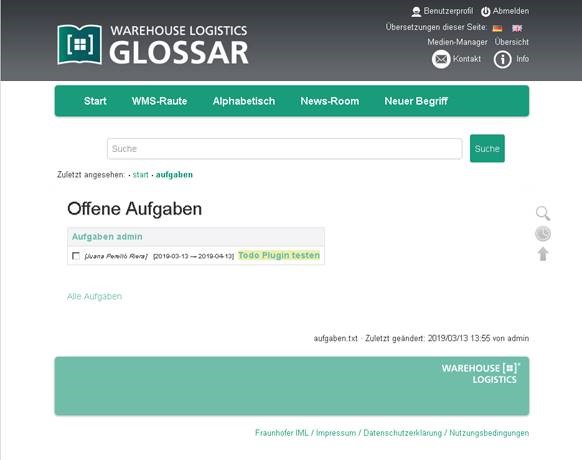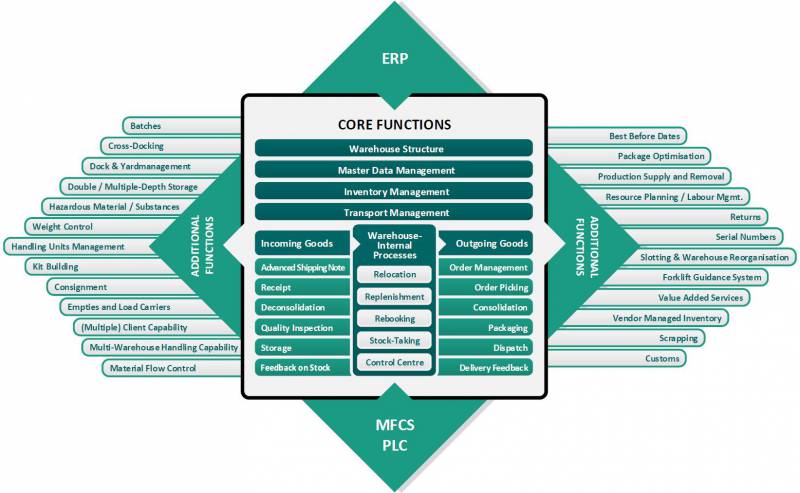Table of Contents
About the »warehouse logistics«-glossary
The »warehouse logistics«-glossary for the WMS environment is a joint effort of the »warehouse logistics« team of the Fraunhofer IML and the »warehouse logistics«-community.
The glossary contains terms and their definitions from the field of WMS, which can be accessed by both WMS providers and interested externals. The term base of this glossary can be continuously extended and validated by the »warehouse logistics«-community. Thus a uniform basis and a common understanding of the terms in the WMS market shall develop.
1. How does a term get into the glossary?
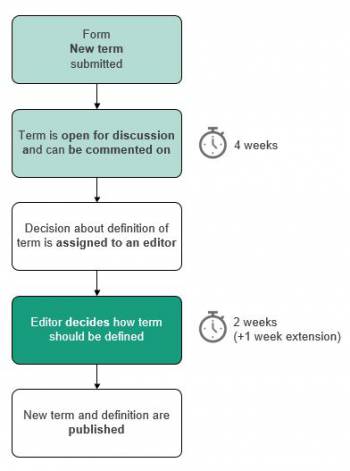
The »warehouse logistics«-glossary is a constantly growing reference work in which the term base can be continuously expanded. Committed users from the »warehouse logistics«-community are encouraged to suggest terms from the WMS environment that have not yet been included for the term base. For this purpose, a term definition for the extension of the glossary may be recommended on the page „New term“. All fields marked with an asterisk must be completed.
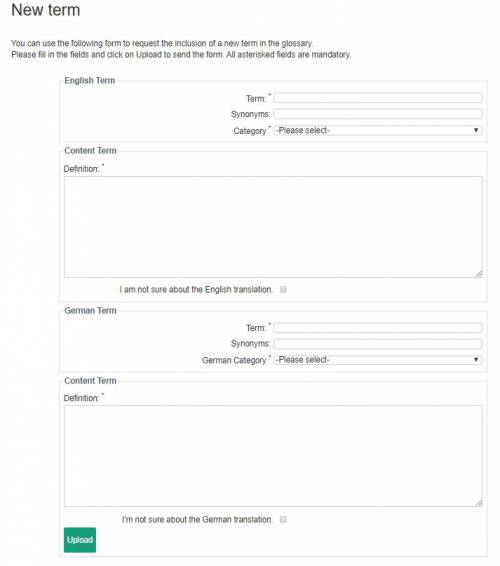
Under “term”, the term to be added is entered. The entry of one or more synonyms under “Synonyms” is optional. The selection menu “Main category” contains the main categories of a WMS to which a term can be assigned. These categories refer to the WMS Diamond. After selecting core functions or additional functions, a further selection menu appears with the respective subcategories, from which a suitable category must also be selected. For “Definition”, the definition of the term to be added must be entered.
The lower part of the form refers to the English translation of the term to be created and must be completed according to the same principle as the German part.
If there is uncertainty about the German or English translation of the term or definition, this can be indicated by checking the corresponding box below the definition field.
After the form has been uploaded, the term is marked as “open for discussion” for four weeks and can be commented by all registered users during this time. At the end of the four weeks, the term will be assigned to an editor who will then review the term and the comments written during the discussion time. Within the framework of this review, the editor decides with which wording the term, including the definition, is to be included in the glossary.
2. How to change definitions of terms?
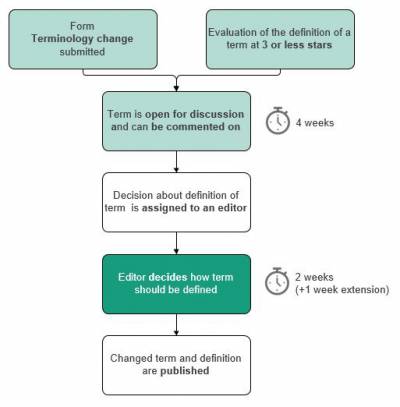
In order to come closer to the goal of a uniform wording for the WMS environment, it is possible to change existing term definitions. Registered users can suggest their desired term change to the »warehouse logistics«-community in order to initiate a change process.
Using the function "Terminology change", a form is opened in which the proposed change can be entered. The structure of this form is similar to that of the form for creating new terms.
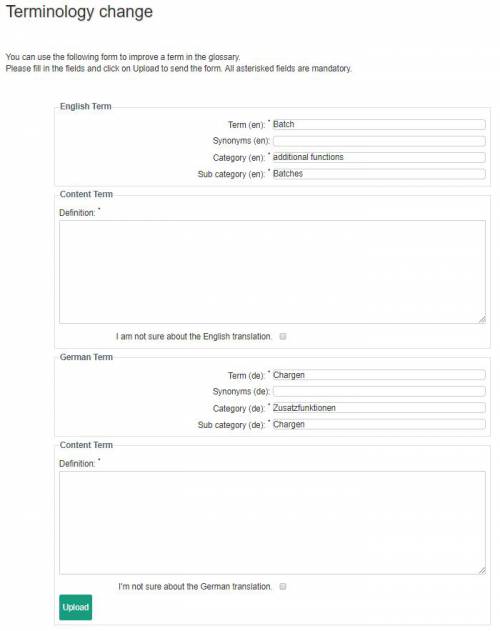
Just like a new term, a term change is put up for discussion for the community for four weeks. During this time, all registered users can comment on the proposed change.
A comment panel is provided on the term page for this purpose. Use the text field and click on “Save” if you want to publish your comment. The comments can be viewed by any user group.
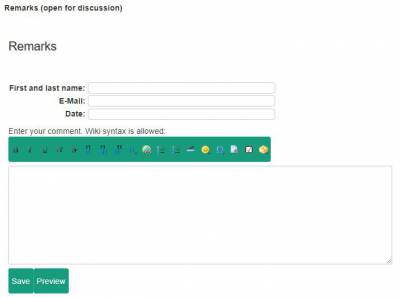
At the end of these four weeks, the term will be assigned to an editor who will then review the proposed change and the comments made during the discussion period. During this review, the editor decides whether the term is to be changed or what changes are to be made to the term definition. It is also possible to allow more than one definition for a term.
In addition, the evaluation function enables anyone who visits the »warehouse logistics«-glossary to provide feedback on existing definitions. To do this, you must select the desired quality (indicated in stars) and then click on “Go”. Existing evaluations for each user profile can also be viewed here.
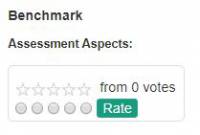
Terms whose definitions are marked with 3 or less stars will also be opened for discussion in order to find a better mutual definition.
3. How can terms be searched?
This glossary provides various ways of classifying terms and thus searching for them.
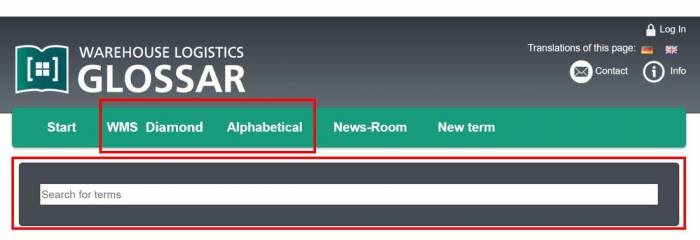
- A search field for the specific term search is arranged cross-page underneath the function bar.
- The alphabetical list of all terms is used for a quick search based on initial letters:
4. How can terms be found that are currently open for discussion?
The News-Room provides an overview of all terms that are currently open for discussion. In addition, for each term is displayed until when it is open for discussion.
A second list contains all terms that are currently being edited. Here you can see for each term until when it will be edited.
Additionally, all recently changed terms are listed with the respective change date.
5. Which user groups exist and how do they differ?
The users of the »warehouse logistics«-glossary can be divided into three user groups: If you, as an interested external person, have become aware of the »warehouse logistics«-glossary, you can view the existing definitions, but not change them. If you have registered as a WMS provider for the »warehouse logistics«-glossary, you will initially start as a standard user. If you would like to become an editor, you can simply send an informal mail with the info “I would like to become an editor for the glossary” to web-admin@warehouse-logistics.com.
Both groups, standard users and editors, have full access to the standard functions for using the glossary, i.e. the News-Room, the rating and comment function, the creation of new terms and the change of existing terms. In addition, editors take over some important additional functions: Editors can not only provide suggestions for the terms in our glossary, they have the right to participate and are involved in the decision-making process for the final definition of terms. This enables editors to play a crucial role in the process of finding the formally correct wording in the WMS market.
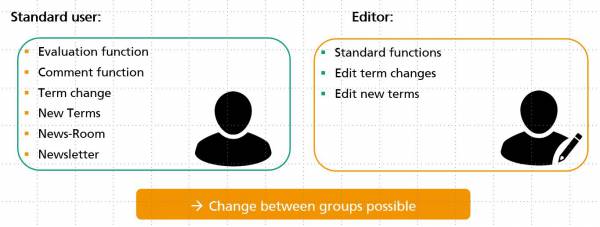
6. What are the tasks of an editor?
Editors are responsible for checking new terms and checking change proposals for existing terms.
At the end of the four-week discussion, the term is assigned to an editor and the editor is informed of the assignment by e-mail. The editor then has two weeks to review the term and the comments written during the discussion. In the course of this review, the editor decides for a new term with which formulation the term including definition is included in the glossary and edits the term page accordingly. If there is a terminology change, the editor decides whether the term is to be changed or which content change is to be made to the term definition and edits the term page accordingly.
Editors can only edit the terms assigned to them. In order to edit a term, the editing function must first be opened by selecting the “Edit” button at the bottom to the right of the page. The individual text elements can then be adapted in this function. The “Preview” button can be used to display the changes for checking purposes without them being implemented directly. As soon as the desired changes have been made, they must be confirmed using the “Save” button.
After the editor has edited the term, the task must be checked off on the task page as completed.
tasks page
Editors have access to a personal task page. All pending tasks are displayed on this page. This includes the review of new terms, as well as the review of change proposals. To each editor only his/her own tasks and the corresponding deadline are displayed. A check mark can be placed in the box in front of each task to indicate that it has been completed.
